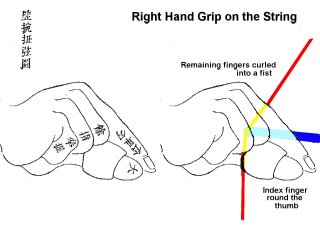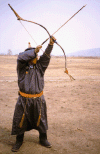

Use the following tips at your own discretion. We cannot be liable for any injury you might suffer due to practicing without a qualified coach.
Most Asian archery is performed with a Mongolian draw and a thumb ring. There are two common styles of ring: one is a simple cylinder of bone or stone; the other is a ring with a rigid tab which fits over the pad of the archer's thumb. The former can sometimes be found in Chinese crafts and antique shops. The latter can be made easily by making a copper ring to fit loosely over your thumb, then fitting a piece of shoe leather around the inside so that it fits snugly when worn, and a thick leather tab extends out from the inside of the ring to cover the pad of your thumb.
There are a number of important matters to consider before using the Mongolian draw:
Grip the bow with the main weight to be taken at the web of the thumb, opposite the index finger. The thumb should curl around to extend past the point of the index finger. When the bow arm is extended, the top side (not the bottom side) of your bow arm should be perfectly level. The bow hand must not tilt upward. The remaining three fingers curl around the grip as if grasping an egg. They should exert a firm inward pressure on the bow grip without straining. Point at the target with the first joint of the thumb: not the index finger. That will encourage the elbow joint to take the correct position. The cup of the elbow joint should point upward and the knob downward. This will help you to prevent your shoulder from coming up.
In the Mongolian draw, the shaft of the arrow rests on the thumb/forefinger junction at the grip of the bow (not on the knuckle). For the right-handed archer, the arrow will pass to the right of the grip and for the left-handed archer, to the left. This may be the opposite of what you are used to.
First get the arrow nocked on the string. Place the arrow so that it is at right-angles to the string (not pointed slightly downward.) Draw the arrow back one inch on the string and grip the arrow shaft with the bow-hand fingers like holding a pen. Now the arrow will be held firmly by the tension of the string and you can move around freely with the arrow nocked and held in one hand. Use the string-hand forefinger and the string itself to make a final adjustment to the thumb-ring so that it is comfortable at the base of the thumb, then hook the thumb around the string with the string at the bottom of the ring, adjacent to the base of the thumb. Curl the index finger around to support the thumb just behind the nail. (Not on the nail itself. And ensure that the nail is cut short!) Curl the remaining three fingers back and press them lightly into your palm. Lower both arms so that the arrow is pointed forward at the ground about metre in front of your feet; take the strain of the string, drawn about an inch, back from the bow-hand fingers and re-arrange the bow-hand fingers as described above. Relax your body completely and clear your mind.

The Draw
Raise the bow and and string hand high to come into the draw. Inhale while you are doing so.

Draw smoothly pulling back and down with the string hand and pushing forward and down with the bow hand. You should be able to draw the arrow so that the draw-hand is above your nipple and the bow-hand is extended straight out. Do not let the draw-hand elbow droop. Do not let the bow-hand turn up. Keep your shoulder from hunching. Do not try to release with the arrow at eye-level. You cannot sight down the arrow without spoiling the draw. If your bow-hand is slanted upward to eye-level, when you release it will drop and spoil the shot.
The Full-draw and Release
When the arms are quite level, there is a straight line from the bow-hand wrist, through the elbow to the shoulders and then back to the string-hand. For elevation, raise the bow hand and drop the draw-arm elbow in co-ordination: but keep them in a straight line. Do not bend back at the waist. Your body should be perfectly vertical and your head as if suspended from the top with a string from the sky. At this point, try to push the breath in your chest down into your abdomen. Use the back muscles to bring the arrow back: it is not ready for release until the arrow head can be felt touching the junction between the bow-hand forefinger and thumb. Do not jerk back: let the arrow come back slowly and allow the feel of the arrowhead arriving act like a clicker: relax the draw-hand forefinger and thumb simultaneously. The arrow leaves the bow and the the draw-hand elbow falls back. Release your breath gently.
The bow-hand must not react! It must remain perfectly still. Do not drop the bow hand, fling back the string hand or do any theatricals. Just remain still and relaxed. Observe the flight of the arrow and correct your faults accordingly.
Concentration
As you draw the string back, you concentrate on the target. Pick the smallest point visible on the target. If it is a target butt, concentrate on a hole left by a previous shot: not on the whole yellow circle. If the target is an animal, concentrate on a single hair or feather, not on the breast.
Between the time when you feel your arms and shoulders are level, and before the arrowhead reaches the finger of the bow hand, maximize your concentration. But do not concentrate on the target: you already know where it is and your mind and limbs already know what you want to do. Concentrate instead on your shot. Concentrate on the feeling of the shot being right. Wait for the feeling of the arrowhead on the finger, and when it arrives, do not hesiate: relax and release. The release is not anticipated. It is like a dragonfly touching the surface of a pond or a ripe gourd falling off the vine.
This is the correct technique for the draw as described by the Chinese author, Gao Ying, in 1637. It is consistent with traditional Mongolian practice, and forms the basis of certain (but not all!) schools of Japanese Kyudo.
© Stephen Selby 1998.
Up-dated 5 October 1998